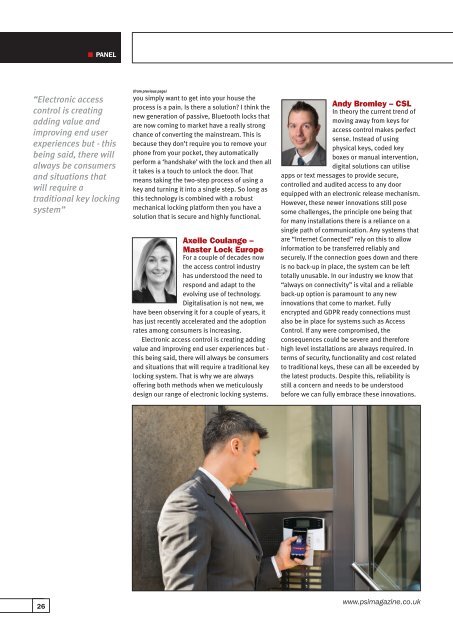PSIJuly2018
You also want an ePaper? Increase the reach of your titles
YUMPU automatically turns print PDFs into web optimized ePapers that Google loves.
PANEL<br />
“Electronic access<br />
control is creating<br />
adding value and<br />
improving end user<br />
experiences but - this<br />
being said, there will<br />
always be consumers<br />
and situations that<br />
will require a<br />
traditional key locking<br />
system”<br />
(from previous page)<br />
you simply want to get into your house the<br />
process is a pain. Is there a solution? I think the<br />
new generation of passive, Bluetooth locks that<br />
are now coming to market have a really strong<br />
chance of converting the mainstream. This is<br />
because they don’t require you to remove your<br />
phone from your pocket, they automatically<br />
perform a ‘handshake’ with the lock and then all<br />
it takes is a touch to unlock the door. That<br />
means taking the two-step process of using a<br />
key and turning it into a single step. So long as<br />
this technology is combined with a robust<br />
mechanical locking platform then you have a<br />
solution that is secure and highly functional.<br />
Axelle Coulange –<br />
Master Lock Europe<br />
For a couple of decades now<br />
the access control industry<br />
has understood the need to<br />
respond and adapt to the<br />
evolving use of technology.<br />
Digitalisation is not new, we<br />
have been observing it for a couple of years, it<br />
has just recently accelerated and the adoption<br />
rates among consumers is increasing.<br />
Electronic access control is creating adding<br />
value and improving end user experiences but -<br />
this being said, there will always be consumers<br />
and situations that will require a traditional key<br />
locking system. That is why we are always<br />
offering both methods when we meticulously<br />
design our range of electronic locking systems.<br />
Andy Bromley – CSL<br />
In theory the current trend of<br />
moving away from keys for<br />
access control makes perfect<br />
sense. Instead of using<br />
physical keys, coded key<br />
boxes or manual intervention,<br />
digital solutions can utilise<br />
apps or text messages to provide secure,<br />
controlled and audited access to any door<br />
equipped with an electronic release mechanism.<br />
However, these newer innovations still pose<br />
some challenges, the principle one being that<br />
for many installations there is a reliance on a<br />
single path of communication. Any systems that<br />
are “Internet Connected” rely on this to allow<br />
information to be transferred reliably and<br />
securely. If the connection goes down and there<br />
is no back-up in place, the system can be left<br />
totally unusable. In our industry we know that<br />
“always on connectivity” is vital and a reliable<br />
back-up option is paramount to any new<br />
innovations that come to market. Fully<br />
encrypted and GDPR ready connections must<br />
also be in place for systems such as Access<br />
Control. If any were compromised, the<br />
consequences could be severe and therefore<br />
high level installations are always required. In<br />
terms of security, functionality and cost related<br />
to traditional keys, these can all be exceeded by<br />
the latest products. Despite this, reliability is<br />
still a concern and needs to be understood<br />
before we can fully embrace these innovations.<br />
26<br />
www.psimagazine.co.uk

















